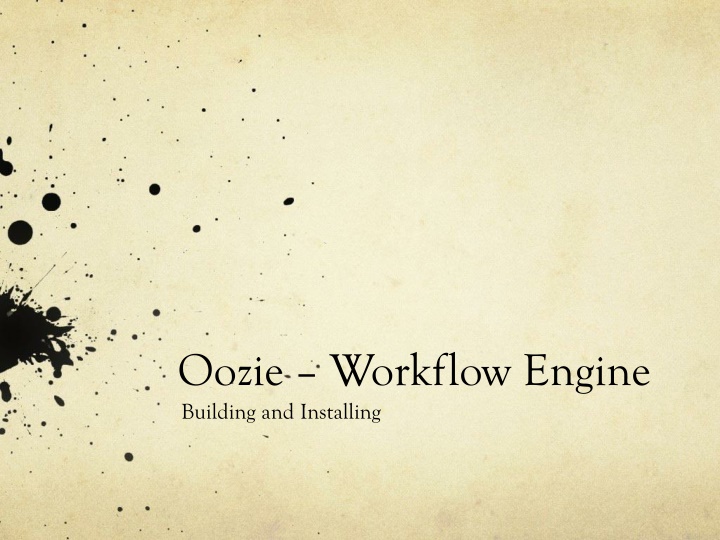
Full Guide to Building and Installing Oozie Workflow Engine
Learn how to build and install the Oozie Workflow Engine step-by-step, including prerequisites, building process, setting up required libraries, and configuring Hadoop. Get insights on every detail necessary for a successful installation.
Download Presentation

Please find below an Image/Link to download the presentation.
The content on the website is provided AS IS for your information and personal use only. It may not be sold, licensed, or shared on other websites without obtaining consent from the author. If you encounter any issues during the download, it is possible that the publisher has removed the file from their server.
You are allowed to download the files provided on this website for personal or commercial use, subject to the condition that they are used lawfully. All files are the property of their respective owners.
The content on the website is provided AS IS for your information and personal use only. It may not be sold, licensed, or shared on other websites without obtaining consent from the author.
E N D
Presentation Transcript
Oozie Workflow Engine Building and Installing
Pre Requisites Oozie-4.1.0.tar.gz Apache maven 3.3.3 Jdk 1.6 or greater
Building oozie To build oozie you can use the following command: Bin/mkditro.sh DskipTests The above command should build all the projects included in your oozie source folder and should create a binary distribution of oozie that we will use to install client and server. After a successful build, create a new folder called oozie so that we can move our binary distribution to an individual folder
Use the following command: cp -R oozie-4.1.0/distro/target/oozie-4.1.0-distro/oozie- 4.1.0/ oozie Change your directory to oozie and create a new directory with in it called libext, we will use this directory for the required hadoop libs. mkdir libext Next we need to copy all the required hadooplibs into ext folder.
For that locate hadooplibs folder with in your oozie4.1.0 directory. As you can see there are two hadooplibs folder, in these we have the tar files and we need to extract one of them.
After extracting the hadooplibs we need to move the libraries to libext, using the following command: cp oozie-4.1.0/hadooplibs/hadooplib-2.3.0.oozie- 4.1.0/* libext/ The above command will make all the hadooplibs available to oozie. We need to make one configuration change in hadoop.
Update ../hadoop/conf/core-site.xml as follows: <property> <name>hadoop.proxyuser.hduser.hosts</name> <value>localhost</value> </property> <property> <name>hadoop.proxyuser.hduser.groups</name> <value>hadoop</value> </property> Here you need to mention the host and if you have a specific user hadoop.
Run the following commands to install oozie: /bin/oozie-setup.sh prepare-war
Create sharelib on HDFS $ ./bin/oozie-setup.sh sharelib create -fs hdfs://localhost:54310 setting CATALINA_OPTS="$CATALINA_OPTS - Xmx1024m" the destination path for sharelib is: /user/hduser/share/lib ./bin/ooziedb.sh create -sqlfile oozie.sql run ./bin/oozied.sh start ./bin/oozied.sh run
After the run command the oozie server should be up and running. To monitor the status run the following command: $ ./bin/oozie admin -oozie http://localhost:11000/oozie -status You should get the following status: System mode: NORMAL
